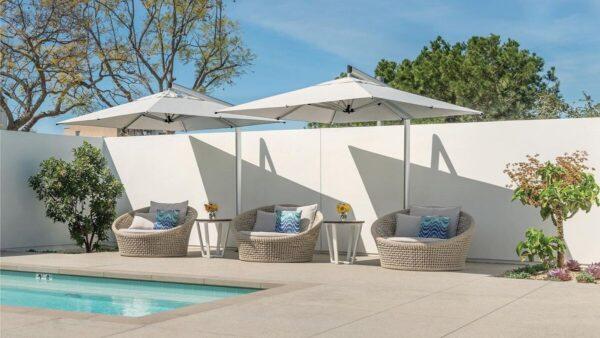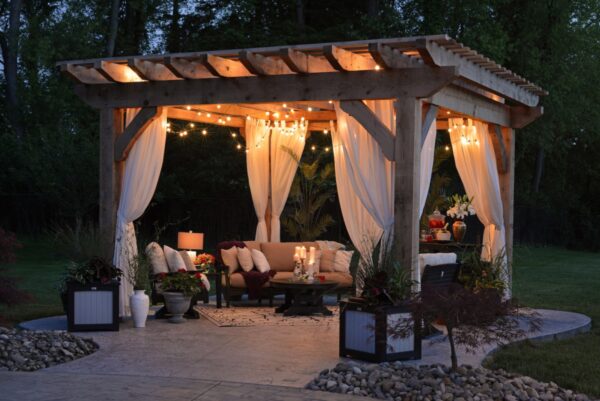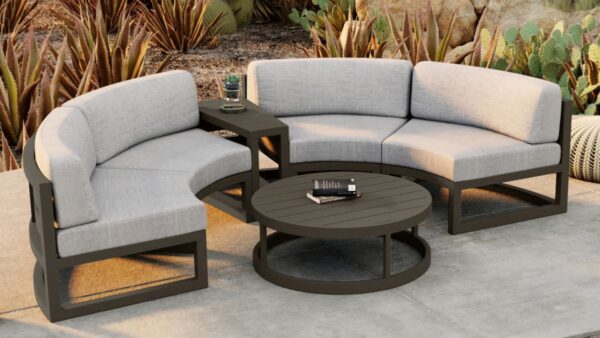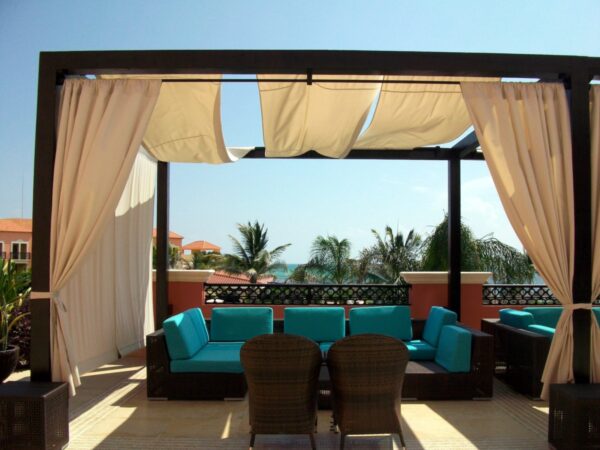Ahhh, it’s the season of summer days, pool parties, and barbecues—all fun activities that come with a downside most of us can agree we don’t enjoy: the heat. With your favorite patio furniture and a great view, who wouldn’t want to stay outside all day long? Unfortunately, a beautiful patio isn’t necessarily an all-access pass to an oasis of coolness. It’s time to take matters into your own hands and learn how to beat the heat this summer.
- Introduction to Camouflage Security Cameras: Creative Ideas for Disguising and Enhancing Home Safety
- What Is the Best Floor for My Bunny Enclosure?
- Best Motion Sensor Security Cameras
- Awesome and Affordable Outdoor Gifts for Teens: 2022 Edition
- 20 Best Tan Accelerators for an Intensified Golden Glow
No matter the temperature, you can keep your patio cozy and cool thanks to a few easy tricks. That’s why today we’ll explore the top 5 ways to cool off your patio and make it a summer haven. We might not be able to control the climate, but at least we can steer the patio vibes in a chill direction! Read on to find ways to keep your outdoor hangouts from getting too hot in the summer sun.
You are watching: How To Keep A Patio Cool – Beat The Heat
The Five Best Ways to Cool Off a Hot Patio
The five best ways to cool off your patio in the blistering summer months are: add some shade with umbrellas or sails, plant trees and bushes that will cast shadows and evaporate water, set up canopies and awnings, choose the right patio furniture materials, and use misters and fans. If you pick just one of these, you’ll have your patio cooled down in no time!
Get Some Shade

Getting some shade is the quickest and simplest way to cool off your patio. A large umbrella or an awning will provide enough shade to make a huge temperature difference. Umbrellas can be cheap and easy to move around, so they are great for temporary relief. Awnings are sturdier, longer-term solutions with larger coverage areas. Both have immediate benefits, but putting up an awning takes more time and effort than putting up and taking down a nice umbrella.
Also, having shade protects you from the sun’s harmful UV rays, which is a bonus. Studies have shown that our skin and eyes get hurt when we are exposed to ultraviolet light for a long time. Putting shade over your patio can help stop these bad things from happening when the sun shines directly on it.
Even though shade on your patio has clear benefits, like keeping you cool right away and protecting you from UV rays, it’s important to consider the downsides as well. Umbrellas are limited in size, shape, and mobility options; the largest sizes may not fit over certain table sets or furniture configurations. On the other hand, if you choose an awning, you might run into hard-to-understand installation instructions or be limited by how your home is built or designed.
With that in mind, we now turn towards increasing the vegetation around your patio with trees and bushes—a natural source of shade and cooling!
Plant Trees and Bushes

Trees and bushes are among the simplest and most affordable ways to cool off your patio. Not only do they provide a natural shade, but trees and shrubs also help reduce air temperatures by evaporating water back into the atmosphere through their leaves. If you want immediate relief from hot, direct sunlight, you could plant fast-growing deciduous trees like maples or birches. These trees will create a canopy that can keep your patio shaded in the summer months while allowing much-needed sunlight to pass through in the winter.
So, if you want to cool off your patio by planting trees and bushes, be aware of possible problems. Consider your neighbor’s yard, too; large trees will not only block sunlight in your backyard but could cast shadows onto your neighbor’s patio. Also, make sure you have enough room for the tree or bush to grow to its full height and width before you plant it.
Quick Tips for Trees and Bushes:
Trees and bushes are an affordable way to cool off patios; they create natural shade, help reduce air temperatures, and can be deciduous trees (e.g., maples or birches) that provide sun protection in the summer and let sunlight in during the winter. However, people should consider their neighbor’s yard when planting trees so that shadows do not cover their patio; also, make sure there is enough space for the mature height/spread of the tree or bush. Additionally, setting up canopies and awnings provides additional sun protection.
Now that you have some tips on using trees and bushes to cool off your patio let’s take a look at setting up canopies and awnings for additional sun protection.
Set Up Canopies, Awnings

Adding canopies and awnings is a great place to start when creating a cost-efficient and stylish way of cooling off your patio. Canopies are free-standing structures that block the sun and other weather conditions, like rain or wind. On the other hand, awnings provide shade in a similar way, but they are attached to the sides of buildings or platforms outside. As a result, they’re ideal for those who want to add extra protection to their patios without erecting an entire canopy structure.
However, there are two sides to this argument. On one end, you have those who prefer the convenience and ease of maintaining awnings as opposed to canopies, which need more comprehensive checking as they aren’t directly attached to any building. On the other end are those who feel that canopies offer greater protection against different elements simply because they cover more area—also allowing them to be moved more easily should the space require cooling in different spots during the summer months.
Knowing the pros and cons of keeping up with your patio during the hot summer months can help you choose a long-term solution for shading. Now that we’ve discussed setting up canopies and awnings, let’s look at how making your patio materials count can also help keep you cool and comfortable throughout those warmer months.
Make Your Patio Materials Count
When trying to stay cool on your patio, the materials you choose for your furniture and decor can greatly impact the overall temperature. Selecting the right material to make the most of your space is important. Some materials are better at absorbing heat, while others are better at reflecting it away.
Read more : 20 Outdoor Scavenger Hunt Riddles For Family Fun
Dark-colored materials, like wood and stone, are best at absorbing heat, so they soak up the heat and then radiate it back into your space. In the same way, metallics tend to keep heat and, depending on where they are, can get dangerously hot. If your patio gets a lot of direct sunlight, these materials should be avoided entirely.
On the other hand, lighter-colored materials like wicker or canvas are great for keeping the heat out since they deflect and reflect more of the sun’s heat away from your outdoor space. Natural fibers like jute, cotton, and hemp can also keep heat away and absorb it, making them perfect for people who live in very hot places.
No matter what materials you choose for your patio, you should always plan and make sure that whatever you choose will stand up to storms and too much sun. With the right selection of materials, you’ll be able to keep your patio cool even during extensive periods of heat.
Now that we’ve discussed how materials affect patio cooling let’s move on to our next topic: choosing decor and furniture made from weather-resistant materials.
Choose Decor and Furniture Made From Weather Resistant Materials

Choosing the right furniture and decor for your patio is important in creating a cool and inviting outdoor area. Materials that can stand up to the elements should be your first choice when deciding on furnishings. Using aluminum for the frames and weather-resistant materials like resin or teak can help protect your patio from bad weather. You’ll want to opt for fabrics that are outdoor rated, like Sunbrella, or made from a synthetic material that is designed to resist fading, mildew, and moisture.
While furniture and fabrics made from these materials may come with a higher price tag up front, they will save you money in the long run since they require less maintenance than items made of less durable materials. On the other hand, decorative pieces made of wood, plastic, or other more affordable options can still work well outdoors if given regular attention and cleaned and cared for properly, according to manufacturer recommendations. Protecting certain items with a waterproofing spray may sometimes be necessary.
No matter which option you choose, selecting patio furniture and decor made from weather-resistant materials is wise to help you get the most out of your outdoor space while offering greater peace of mind that it will last through all four seasons.
Now that you have chosen the right furniture and decor for your patio, let’s focus on using fans and misters to create an optimal setting for cooling off your patio in the hottest summer months.
Use Fans and Misters

Fans and misters are a great way to cool off outdoor areas such as patios. Ceiling fans can be installed in covered patios to help circulate air and keep the space cooler, while portables are available to move around to maximize effectiveness. Misters also provide cooling relief on hot days by releasing a fine mist of water into the air, which evaporates and helps cool down the area. Because these devices help with high temperatures right away and directly, they are great for places where shade is hard to find or doesn’t offer much relief from the summer heat.
On the other hand, fans won’t necessarily reduce the temperature of your patio very much since most fans don’t have powerful enough motors to cause a significant drop in actual temperature. Even when widely dispersed, mister systems can have inconsistent results when creating a uniform cooling effect throughout a larger patio area. Furthermore, both require electricity which adds cost over time; if you already have efficient LED lighting or other existing energy sources, this should not be too much of an issue.
Fans and misters are good ways to keep your patio cool on hot summer days, though it might take some trial and error to find the best temperature. Proper setup and maintenance can work together to keep your patio comfortably cooled in even the hottest climates.
Next up is another effective strategy for staying cool this summer: maximizing your home’s natural breezes.
Create Multiple Breezes Add It All Together
Creating multiple breezes is an effective way to cool off your patio. Wind chimes and light wind sculptures placed in the right places can help move air around your space and make it feel cooler. A steady breeze can also be made by putting a standing or hanging fan on the patio. Aim the fan towards the walls of your house to move even more air around the space, creating maximum relief from the heat. However, some people may be wary of adding an electronic device and remembering to take care of it.
Still, if you plan ahead and do enough research, you can find fans that are durable and easy to take care of that fit any budget. Investment in eco-friendly models will also help to reduce energy costs, making this a much more affordable option.
The next step in reducing the heat on your patio is to use fans and misters. This addition will help you to keep the space comfortable while enjoying the summer weather, no matter how high the temperature rises.
Other DIY Cooling Ideas

Read more : Lost Cat Behavior
People who want more do-it-yourself ideas for cooling might want to look at existing solutions that can be tweaked. For this easy solution, you can use a light fabric that blocks more heat but still lets some light through. Awnings, canopies, and umbrellas are also portable items that can be used to make temporary shade on a patio.
Installing a misting system on a patio can also be a good way to cool off and get some relief from the hottest parts of the day. Depending on the desired kit, these systems may consist of pipes and nozzles attached to a garden hose that circulate clean water into a fine mist – creating a refreshing oasis outside your door. Although more costly than other DIY solutions, these kits are relatively low maintenance and often offer adjustable watering capabilities with automated timers.
On the other hand, some may prefer not to install permanent fixtures like those mentioned previously for various reasons such as aesthetics or expense. Instead, people might fill large bowls or trays with ice cubes and put them near doors or in open parts of a patio to let air flow without taking away from the decor. Alternately, outdoor fans can help move air around hot areas and create a nice atmosphere for gatherings without costing much.
With so many DIY patio cooling solutions available, investing in insulation and wall coverings is another step you can take to ensure long-term comfort all season. Next, we will discuss why adding insulation and wall covers should help beat the heat and cool down your outdoor living spaces.
Insulation and Wall Covers
Insulation and wall covers are both important elements to consider when taking steps to keep your patio cool. Insulating the walls of your patio can help keep it at a comfortable temperature all year, even in the summer when it’s hot. Additionally, insulation doesn’t just protect from rising temperatures – it helps protect from fluctuations in temperature at night, ultimately reducing the amount of energy used to regulate indoor temperatures.
When choosing insulation material, there is an array of different options. Common materials include foam boards, spray foam insulation, recycled denim, and rigid insulation. Depending on the more suitable choice for you and your home, these materials can effectively beat the heat during those steamy summer months.
When it comes to wall coverings, you have a lot of choices for your outdoor space, from fabrics and lattice to shutters and plants. Some might argue that this cover can block sunlight or limit visibility from surrounding areas, but if custom-designed appropriately, it can remain aesthetically pleasing with functioning benefits.
It’s also important to note that even though window screens don’t create physical walls for shade, they prevent small particles, including dust or pollen, from entering your patio’s delicate climate. This helps keep your outdoor space cooler at all times.
Purchasing insulated curtains are another option for those wanting to up their outdoor décor game! Ultimately, there is no single solution for blocking off the heat, and finding a balance between aesthetics and cooling benefits can seem daunting – but with so many options available, it is worth exploring ways to optimize your outdoor experience!
Now that you have a better idea of how insulation and wall covers can make a difference in cooling your patio off let’s move forward into our next section on how you can enjoy the weather on your patio without getting too hot!
Enjoy the Weather on Your Patio
When temperatures rise, and the sun comes out, your patio can become an undesired hotspot. But it doesn’t have to be that way! You can make the most of these warm summer days and enjoy your patio in myriad ways.
A great option is to incorporate furniture pieces into the area that are designed to handle intense sun and heat. Wicker, rattan, and metal chairs, sofas, and tables are all durable materials suitable for prolonged sun exposure and warmth. As a bonus, they will add a stylish touch to your patio. Alternatively, you could opt for wood pieces designed with weatherproofing in mind – apply a waterproof finish before use.
Maximizing natural shade is key to cooling down your patio. If you live in a well-treed area, you can utilize this natural shading effect by strategically placing larger trees or plants around the area to block direct sunlight from the sun. Umbrellas or other covering options should also be considered if the natural shade isn’t available. A retractable cover or canvas awning can offer shade and shelter from the rain in one convenient solution.
Creating an airflow on your patio is another easy way of chilling things down. This can be achieved through manual means such as fans, enclosing part of the area like a screen, or installing cross ventilation systems. To reduce heat gain during summer months, look into opting for window lighting with extended roofs and overhangs on exterior walls that face south or west; this will ensure you have shade during the hottest parts of the day while also allowing you to benefit from natural light when needed.
Finally, don’t forget about incorporating water elements into your design, as these have been shown to have an immediate cooling effect on any outdoor space. This could involve adding mini ponds with small fountains or even misting devices that spray vaporized water in the air around your patio- both of which interact with UV light to achieve their desired result! These tips can help you turn your patio into a cool oasis during the hot summer months.
Here are some of Patio Productions umbrellas to help you beat the heat:
Source: https://gardencourte.com
Categories: Outdoor

